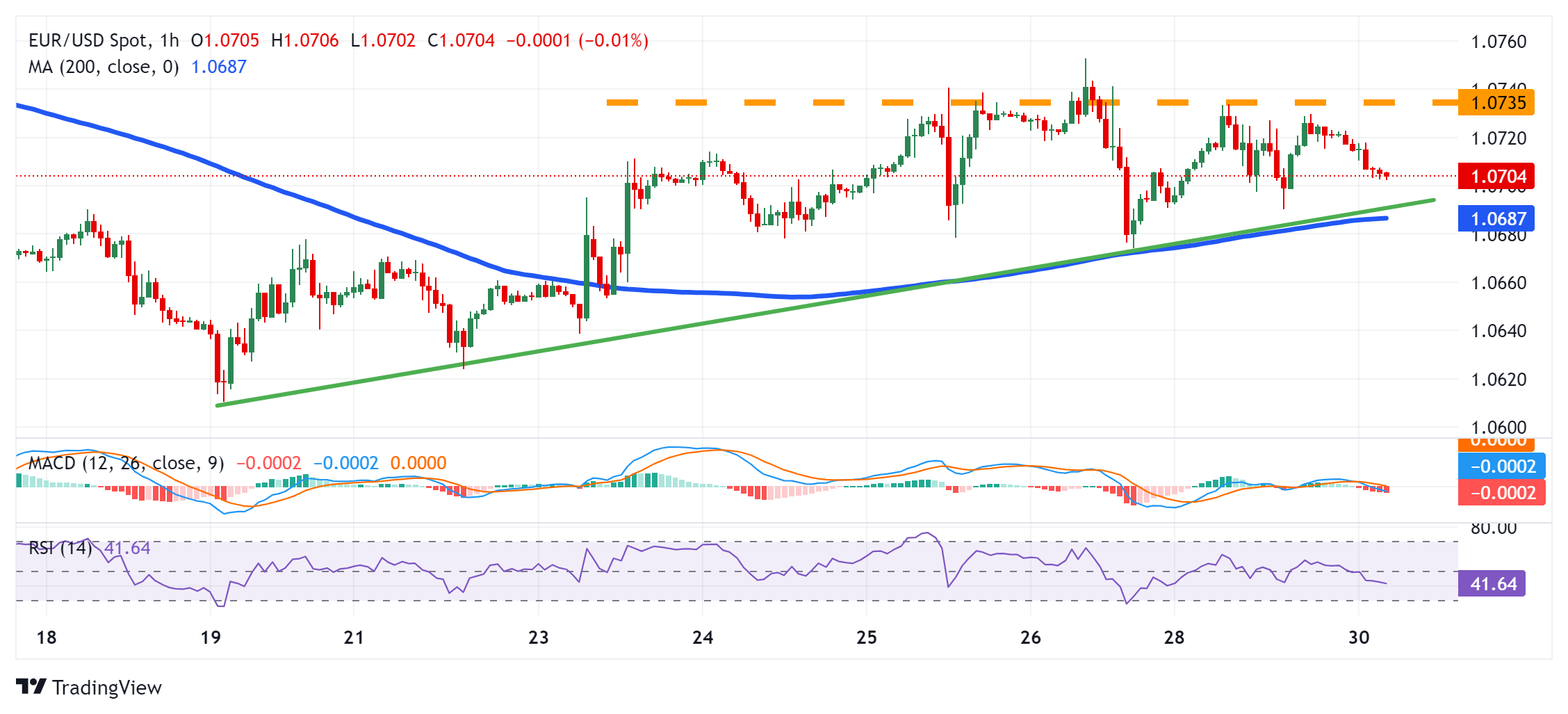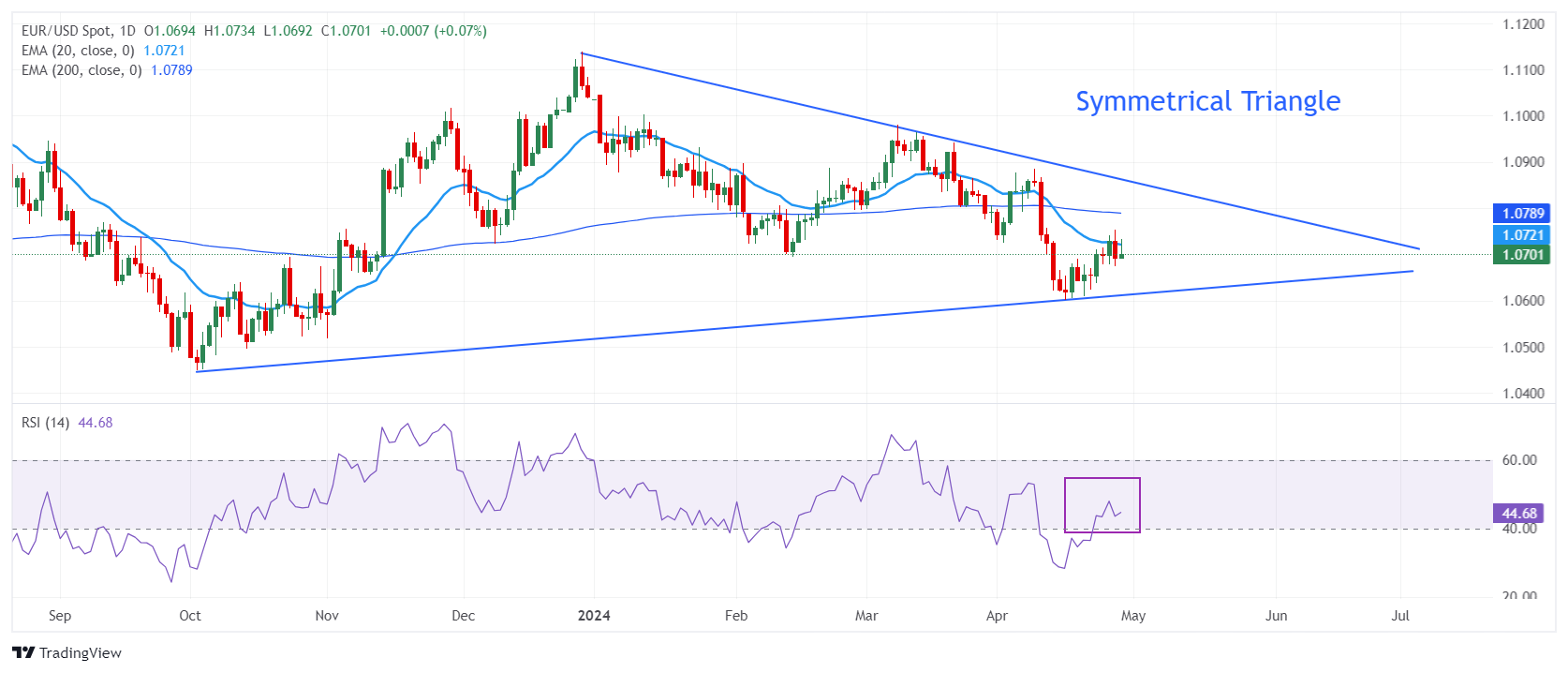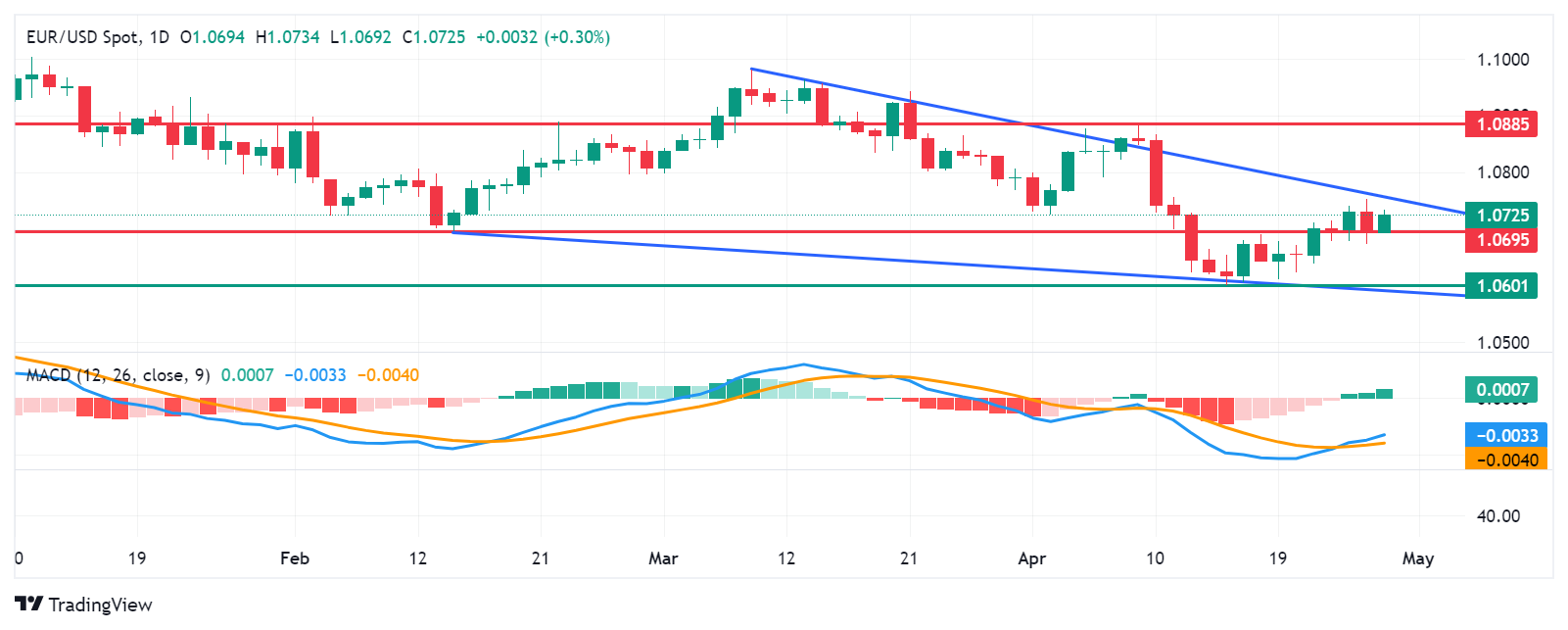- Analytics
- News and Tools
- Quotes
- Chart and quotes for EURUSD
CFD Trading Rate Euro vs US Dollar (EURUSD)
| Date | Rate | Change |
|---|
Related news
-
03.05.2024 21:47EUR/USD breaks above recent congestion as US NFP miss drives down Greenback
- EUR/USD found a fresh high above 1.08 after NFP figures sparked rate cut hopes.
- US economic data came in broadly softer on Friday.
- Coming up next week: European Retail Sales, US consumer sentiment.
EUR/USD drove into a fresh weekly high on Friday, breaking above recent congestion after a broad miss in US Nonfarm Payrolls (NFP) labor and wages figures that reignited broad-market hopes for an accelerated path towards Federal Reserve (Fed) rate cuts.
US NFP comes in soft, hardens rate cut bets
US NFP net job additions in April printed at 175K, below the forecast 243K and falling away from the previous month’s 315K, which was revised upwards from 303K. Average Hourly Earnings grew by 0.2% MoM in April, below the forecast 0.3%.
ISM US Services Purchasing Managers Index (PMI) figures also declined, surprising markets that were expecting an uptick in forward-looking business operator sentiment. April’s ISM Services PMI printed at 49.4, a 16-month low, declining below the contractionary 50.0 level and missing the forecast print of 52.0 versus the previous 51.4.
A sticking point for rate cut hopes was ISM Services Prices Paid, which showed an increase to 59.2 MoM in April as business operating costs accelerate to the upside, climbing from 53.4.
Coming up next week, European Retail Sales figures are scheduled for Tuesday, and median market forecasts are expecting Euro area sales to grow 0.6% MoM in March after the previous month’s -0.5% decline. On the US side, next Friday’s print of the Michigan Consumer Sentiment Index will provide a key finger on the pulse of how deflated consumer expectations for the US economy are getting. May’s Michigan Consumer Sentiment Index is forecast to ease slightly to 77.0 from the previous month’s 77.2.
EUR/USD technical outlook
EUR/USD broke north of recent consolidation on Friday, ticking into a fresh weekly high of 1.0813, climbing out of a rough supply zone between 1.0740 and 1.0720. The week’s low is parked at 1.0650, etching in a near-term swing high as bidders try to knock the pair back into a bullish run.
Friday’s bullish push sent the EUR/USD into the 200-day Exponential Moving Average (EMA) at the 1.0800 handle, with a raft of late-week profit-taking pulling the pair back into 1.0760 as markets head off for the weekend.
EUR/USD hourly chart
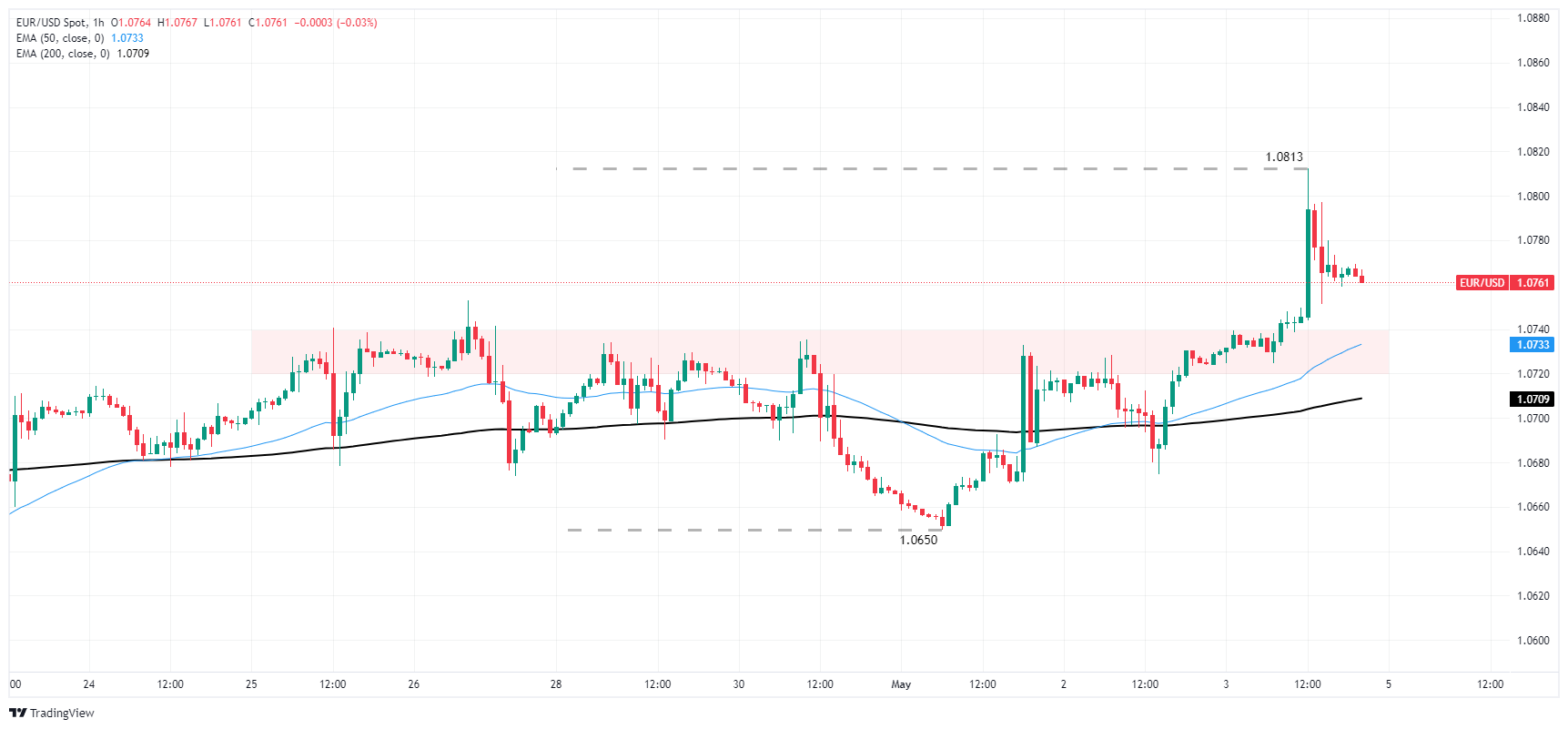
EUR/USD daily chart
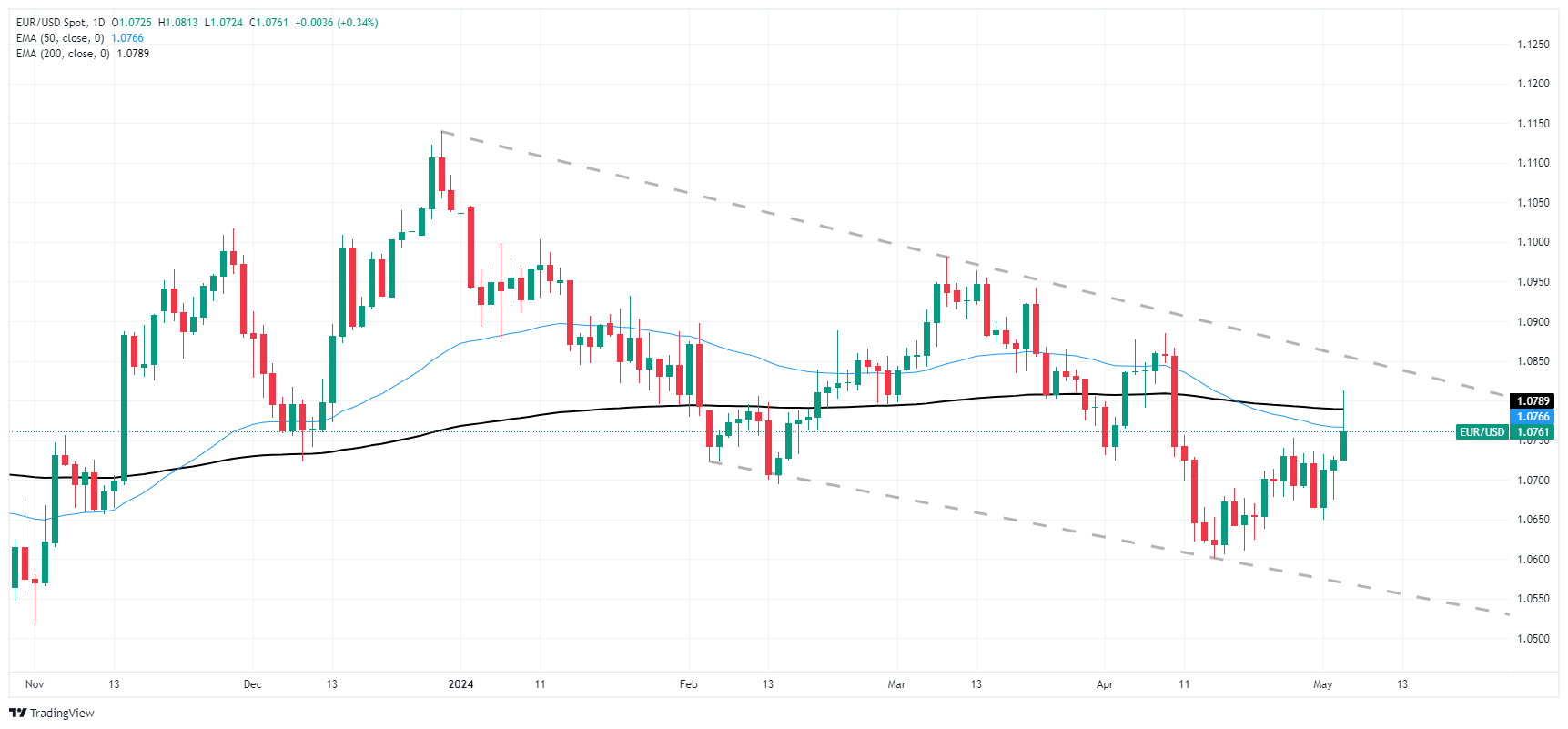
-
03.05.2024 09:53EUR/USD extends winning spell ahead of US NFP, Services PMI
- EUR/USD approaches 1.0750 as the US Dollar weakens ahead of crucial US economic data.
- The ECB is widely anticipated to start reducing interest rates in June.
- The Fed sees rate cuts this year despite little progress in disinflation in the first quarter.
EUR/USD advances to 1.0740 in Friday’s European session. The major currency pair strengthens as the US Dollar (USD) is under pressure due to weak Q1 Nonfarm productivity growth and as the Federal Reserve (Fed) delivered less hawkish guidance on interest rates than feared.
The US Dollar Index (DXY), which tracks the Greenback’s value against six major currencies, trades near a three-week low of around 105.20. Still, investors should remain cautious about EUR/USD longs as the market sentiment could turn sour depending on the outcome of two key data points: the United States Nonfarm Payrolls (NFP) and the ISM Services Purchasing Managers Index (PMI) data for April, which are due in the New York session.
These US economic indicators will provide fresh cues about the state of the labor market and the health of the services sector, two key elements that the Fed takes into account when deciding on interest rates. Currently, traders have increased their bets in favor of the Federal Reserve (Fed) starting to reduce interest rates in the September meeting. These expectations were boosted after Federal Reserve Chair Jerome Powell sounded slightly less hawkish than expected in the latest monetary policy statement and the press conference.
Jerome Powell said that his forecast remained for inflation to fall over the course of the year, but that "my confidence in that is lower than it was." He also acknowledged that inflation “is still too high," adding that "further progress in bringing it down is not assured and the path forward is uncertain", Reuters reported. The Fed also decided to slow down the pace of the balance sheet drawdown, which is another indication that the US central bank leaned toward policy normalization by this year.
Daily digest market movers: EUR/USD rises despite firm ECB rate cut bets for June
- EUR/USD prints a fresh four-day high at 1.0740 due to a sharp decline in the US Dollar. The strength in the major currency pair could fizzle out amid uncertainty ahead of the US NFP and firm speculation that the European Central Bank (ECB) will start reducing interest rates in June.
- The US NFP data will significantly influence market expectations for the Fed’s interest-rate outlook. The consensus shows that fresh payrolls were at 243K, lower than the former reading of 303K. The Unemployment Rate is expected to steady at 3.8%.
- Investors will also focus on the Average Hourly Earnings data, which will provide fresh clues about the inflation outlook. Monthly wage growth is forecasted to have grown steadily by 0.3%. In the same period, annual wage growth is estimated to have dipped to 4.0% from 4.1%.
- Generally, higher wage growth and strong labor demand result in robust consumer spending momentum, which eventually boosts inflationary pressures. This situation would be favorable for the US Dollar and bond yields and would likely weigh on the EUR/USD pair, as it would allow the Fed to maintain a restrictive interest rate framework for a longer period.
- Investors will also focus on the US ISM Services PMI data, a survey that gauges the performance in the services sector, which accounts for two-thirds of the economy. The Services PMI is seen improving to 52.0 from the prior reading of 51.4. Investors will also focus on subcomponents like the New Orders Index and Prices Paid Index, which will reflect the status of new business and service price inflation, respectively.
- On the Eurozone front, the European Central Bank is widely expected to reduce interest rates in June provided there isn’t any surprise with inflation as price growth in the Eurozone is on course to return to the desired rate of 2%. The expectations for the ECB achieving a “soft landing” have improved as the old continent’s economy expanded by 0.3% in the first quarter of this year, outperforming the consensus of 0.1%.
Technical Analysis: EUR/USD advances toward 1.0750
EUR/USD extends its winning spell for the third trading session on Friday and is looking to move higher to near three-week high around 1.0750. The near-term appeal of the currency pair has improved as it has broken above the 20-period Exponential Moving Average (EMA), which trades around 1.0720.
On the daily time frame, EUR/USD exhibits a sharp volatility contraction as price action has formed a Symmetrical Triangle formation. The upward-sloping border of the triangle pattern is plotted from October 3 low at 1.0448, and the downward-sloping border is placed from December 28 high around 1.1140.
The 14-period Relative Strength Index (RSI) shifts into the 40.00-60.00 range, suggesting indecisiveness among market participants.
Euro FAQs
The Euro is the currency for the 20 European Union countries that belong to the Eurozone. It is the second most heavily traded currency in the world behind the US Dollar. In 2022, it accounted for 31% of all foreign exchange transactions, with an average daily turnover of over $2.2 trillion a day. EUR/USD is the most heavily traded currency pair in the world, accounting for an estimated 30% off all transactions, followed by EUR/JPY (4%), EUR/GBP (3%) and EUR/AUD (2%).
The European Central Bank (ECB) in Frankfurt, Germany, is the reserve bank for the Eurozone. The ECB sets interest rates and manages monetary policy. The ECB’s primary mandate is to maintain price stability, which means either controlling inflation or stimulating growth. Its primary tool is the raising or lowering of interest rates. Relatively high interest rates – or the expectation of higher rates – will usually benefit the Euro and vice versa. The ECB Governing Council makes monetary policy decisions at meetings held eight times a year. Decisions are made by heads of the Eurozone national banks and six permanent members, including the President of the ECB, Christine Lagarde.
Eurozone inflation data, measured by the Harmonized Index of Consumer Prices (HICP), is an important econometric for the Euro. If inflation rises more than expected, especially if above the ECB’s 2% target, it obliges the ECB to raise interest rates to bring it back under control. Relatively high interest rates compared to its counterparts will usually benefit the Euro, as it makes the region more attractive as a place for global investors to park their money.
Data releases gauge the health of the economy and can impact on the Euro. Indicators such as GDP, Manufacturing and Services PMIs, employment, and consumer sentiment surveys can all influence the direction of the single currency. A strong economy is good for the Euro. Not only does it attract more foreign investment but it may encourage the ECB to put up interest rates, which will directly strengthen the Euro. Otherwise, if economic data is weak, the Euro is likely to fall. Economic data for the four largest economies in the euro area (Germany, France, Italy and Spain) are especially significant, as they account for 75% of the Eurozone’s economy.
Another significant data release for the Euro is the Trade Balance. This indicator measures the difference between what a country earns from its exports and what it spends on imports over a given period. If a country produces highly sought after exports then its currency will gain in value purely from the extra demand created from foreign buyers seeking to purchase these goods. Therefore, a positive net Trade Balance strengthens a currency and vice versa for a negative balance.
-
03.05.2024 05:06EUR/USD advances to near 1.0750 as risk appetite regains balance
- EUR/USD advances due to positive market sentiment ahead of US Nonfarm Payrolls on Friday.
- The weekly US Initial Jobless Claims remained at the lowest level in two months, prompting the Fed to delay rate cuts.
- ECB Chief Economist Philip Lane emphasized that the central bank will continue to adopt a data-dependent approach.
EUR/USD extends its winning streak for the third successful day on Friday, trading around 1.0730 during the Asian session on Friday. The risk-sensitive currencies like the Euro gain ground as risk appetite regains balance ahead of US Nonfarm Payrolls (NFP). US Nonfarm Payrolls is expected to print a reading of 243K for April, compared to 303K prior. Additionally, Average Hourly Earnings and ISM Services PMI will be released later on Friday. These releases are expected to offer additional insights into the condition of the United States (US) economy.
On Thursday, US Initial Jobless Claims data for the week ending April 26 showed no change from the previous week, remaining at 208K, the lowest level in two months and significantly below market expectations of 212K. This could give the Federal Reserve flexibility to delay interest rate cuts.
US Nonfarm Productivity increased by 0.3% in the first quarter, following an upwardly revised 3.5% rise in the previous quarter, but falling short of the expected increase of 0.8%. This marks the slowest pace of productivity growth since the January-March quarter in 2023.
In the Eurozone, European Central Bank (ECB) Chief Economist Philip Lane said in a virtual guest lecture at the University of Stanford that while inflation has decreased more rapidly than initially anticipated by the ECB, the transmission of policy effects lags. and the tightening impacts from previous rate hikes are still unfolding. Lane emphasized that the ECB is not committed to a specific rate trajectory and will continue to adopt a data-dependent approach.
-
02.05.2024 22:43EUR/USD recovers to top end of consolidation ahead of Friday’s US NFP
- EUR/USD rebounds into high side of near-term range.
- US NFP labor figures to be pivotal data point this week.
- Investors looking for easing labor and slowing wages to bolster rate cut chances.
EUR/USD drove back to the top end of recent consolidation on Thursday, recovering chart territory north of the 1.0700 handle as market risk appetite regains balance heading into another US Nonfarm Payrolls (NFP) Friday.
European economic data is sparse on Friday, leaving investors to focus on US labor figures due early in the American market session. US NFP labor data is expected to show 243K net job additions in the month of April, down slightly from the previous 12-month peak of 303K. With market bets of when and how often the US Federal Reserve (Fed) will finally cut interest rates, investors are hoping for an easing in the pace of hiring to signal a downturn in the US economy which continues to chug along at a breakneck pace compared to most of the developed world.
US Average Hourly Earnings in April are also forecast to hold steady at 0.3% MoM, with wage growth a key fear point for inflationary pressures. At current cut, the rate markets are expecting a first quarter-point trim from the Fed in September, with 62% odds of at least a 25 basis point reduction according to the CME’s FedWatch Tool.
EUR/USD technical outlook
EUR/USD is back into the top side of recent consolidation, testing into the bottom end of a supply zone between 1.0750 and 1.0720. Price action has been cycling the 200-hour Exponential Moving Average (EMA) as markets await a direct driver to influence directional bias.
Daily candlesticks have baked in a pattern of lower highs and lower lows, adding weight to bearish momentum as the pair struggles to develop topside movement from the last swing low into 1.0600. EUR/USD is still trading on the bearish side of the 200-day EMA at 1.0971, and the pair is down 3.7% from the last major swing high into 1.1140 at the tail end of December.
EUR/USD hourly chart
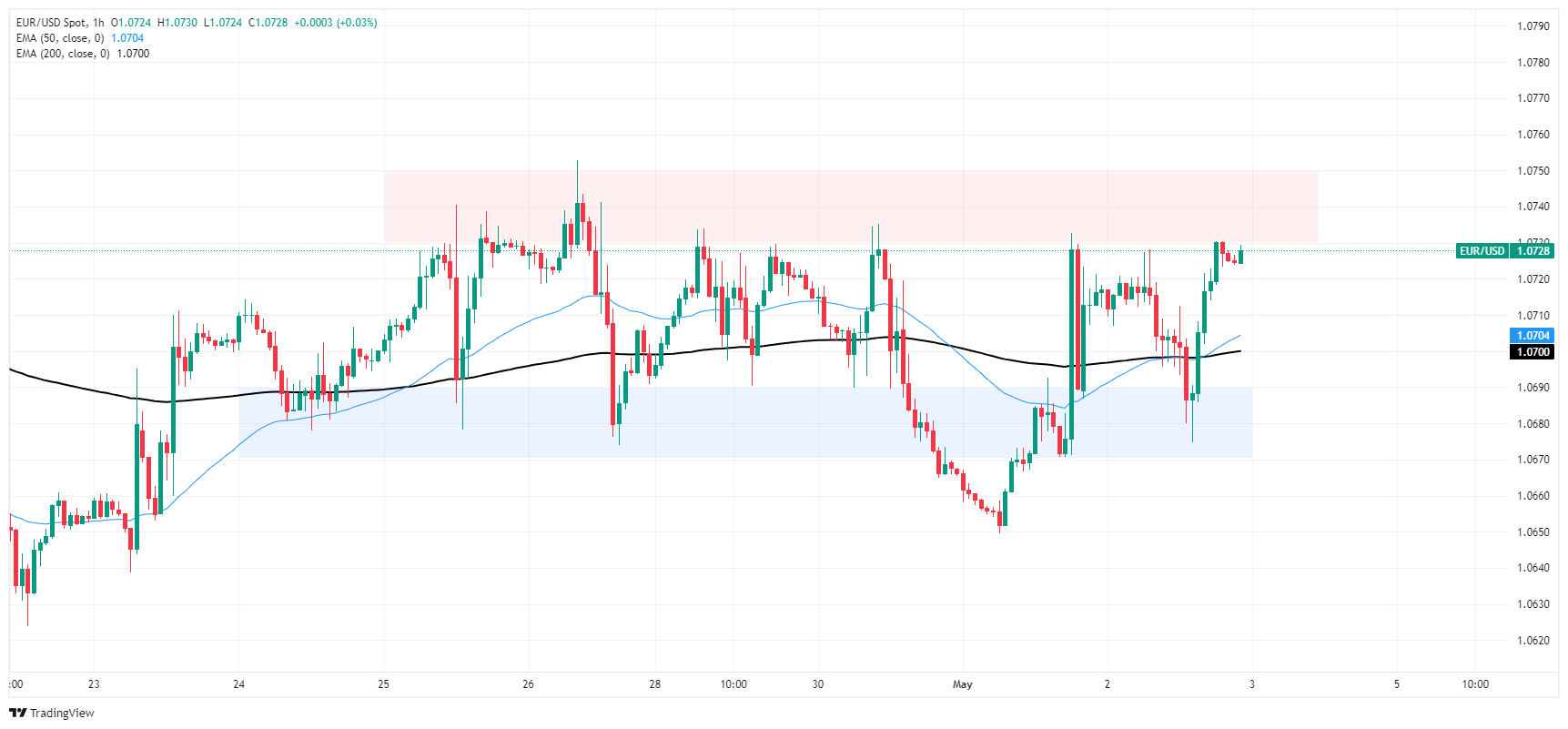
EUR/USD daily chart
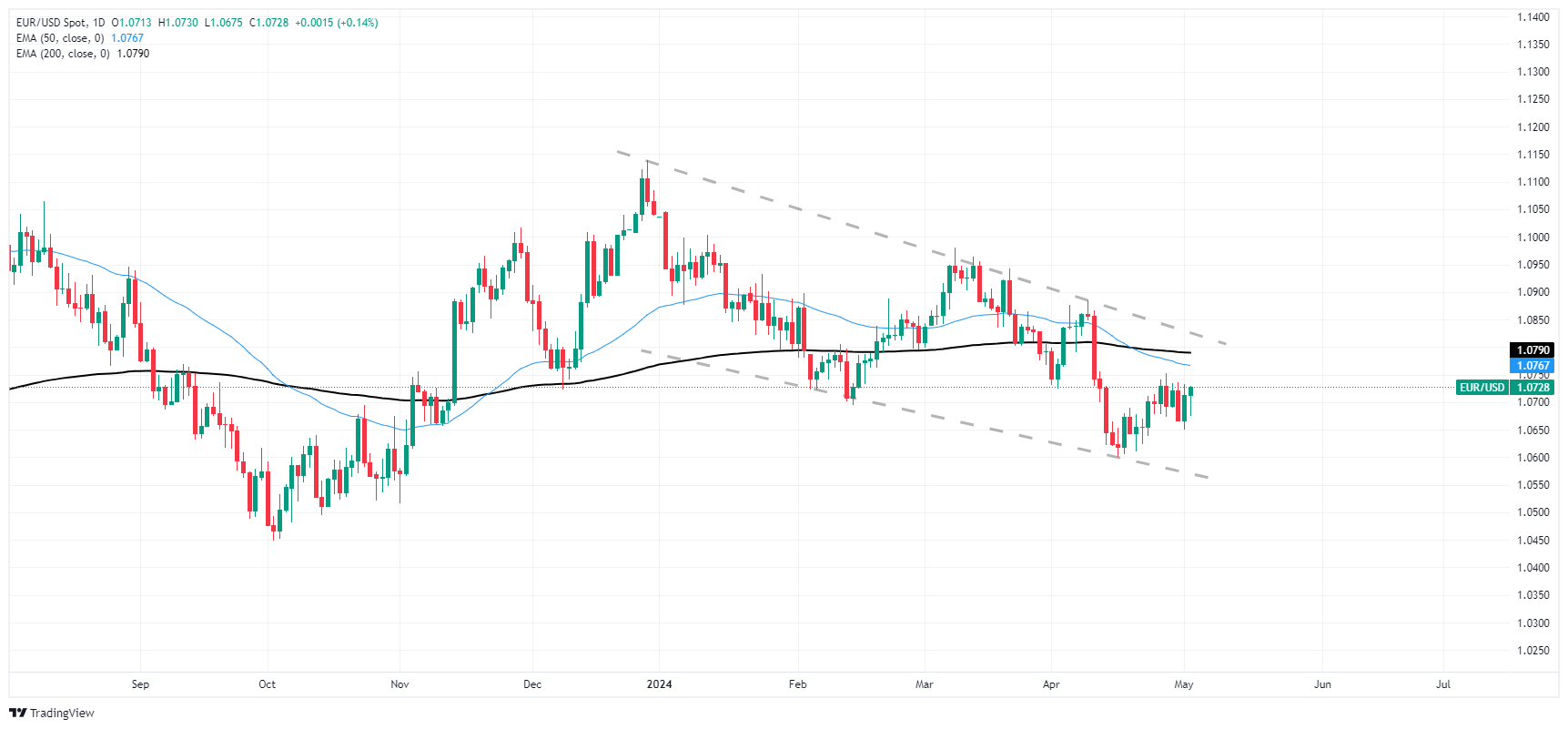
-
02.05.2024 09:45EUR/USD loses momentum as upside remains capped on firm ECB rate cut bets
- EUR/USD trades sideways above 1.0700 as firm ECB rate cut prospects for June offset the Fed’s less-hawkish guidance.
- The ECB is expected to pivot to interest rate cuts in June as Eurozone inflation is on course to the 2% path.
- Fed Powell remains hopeful of rate cuts later this year.
EUR/USD is stuck in a tight range above the round-level support of 1.0700 in Thursday’s European session. The upside in the major currency pair remains restricted around 1.0736 this week as the European Central Bank (ECB) is expected to start lowering its key borrowing rates from the June meeting, while the Federal Reserve’s (Fed) slightly less-hawkish guidance on interest rates has supported the downside.
April’s preliminary inflation readings for the Eurozone showed that annual headline inflation grew steadily by 2.4%. In the same period, the core Consumer Price Index (CPI), which excludes volatile food and energy prices, decelerated to 2.7% from 2.9% in March. Although investors forecasted a sharper decline to 2.6%, the data signalled that Eurozone inflation is on course to return to the desired rate of 2%. Therefore, ECB policymakers remain committed to reducing its Main Refinancing Operations Rate from June.
Meanwhile, ECB policymakers are divided about whether the central bank should extend the rate-cut cycle to policy meetings beyond June. Currently, financial markets speculate that the ECB will cut interest rates three times this year.
On the other side of the Atlantic, the US Dollar is under pressure as the Fed remains optimistic about approaching quantitative easing this year despite acknowledging that progress in reducing inflation to 2% has stalled.
Daily digest market movers: EUR/USD consolidates while US Dollar strives for firm footing
- EUR/USD consolidates in a tight range above the crucial support of 1.0700. The major currency pair fell sharply on Wednesday amid caution before the Federal Reserve’s monetary policy announcement. However, it recovered strongly after the Fed’s guidance on interest rates turned out less hawkish than feared.
- Fed’s decision to hold interest rates steady in the range of 5.25%-5.50% for the sixth time in a row was no surprise for investors but its commentary showed that it is eager to shift to a neutral stance from a hawkish one. Fed Chair Jerome Powell said in his press conference after the Federal Open Market Committee (FOMC) meeting that he still sees interest rates lower this year even though stalling progress in the disinflation process has hit his confidence.
- A sharp decline in the scale of balance sheet tapering was another indication of the central bank’s intention to pivot to quantitative easing gradually. The Fed said that starting on June 1, it will reduce the cap on Treasury securities it allows to mature and not be replaced to $25 billion from its current cap of up to $60 billion per month, Reuters reported.
- This announcement and wording put significant pressure on the US Dollar. The US Dollar Index (DXY), which tracks the US Dollar’s value against six major currencies, is slightly up to 105.75 but has come down significantly from a two-week high of 106.50. The volatility in the US Dollar is expected to remain high as investors await the United States Nonfarm Payrolls (NFP) and the ISM Services PMI data for April, which will be published on Friday. The US NFP is estimated to have grown by 243K, lower than the 303K job additions registered in March. The ISM agency is expected to show a rise in the Services PMI to 52.0 from 51.4 in March.
Technical Analysis: EUR/USD exhibits volatile contraction above 1.0700
EUR/USD trades inside Wednesday’s trading range. The upside in the major currency pair is capped near 1.0735 as the ECB is expected to start lowering interest rates sooner than the Fed. The near-term outlook of the shared currency pair is uncertain as the 20-day Exponential Moving Average (EMA) at 1.0720 continues to be a major barrier for Euro bulls.
On a daily time frame, EUR/USD exhibits a sharp volatility contraction as it forms a Symmetrical Triangle pattern. The upward-sloping border of the triangle pattern is plotted from October 3 low at 1.0448 and the downward-sloping border is placed from December 28 high around 1.1140.
The 14-period Relative Strength Index (RSI) shifts into the 40.00 to 60.00 range, suggesting indecisiveness among market participants.
Euro FAQs
The Euro is the currency for the 20 European Union countries that belong to the Eurozone. It is the second most heavily traded currency in the world behind the US Dollar. In 2022, it accounted for 31% of all foreign exchange transactions, with an average daily turnover of over $2.2 trillion a day. EUR/USD is the most heavily traded currency pair in the world, accounting for an estimated 30% off all transactions, followed by EUR/JPY (4%), EUR/GBP (3%) and EUR/AUD (2%).
The European Central Bank (ECB) in Frankfurt, Germany, is the reserve bank for the Eurozone. The ECB sets interest rates and manages monetary policy. The ECB’s primary mandate is to maintain price stability, which means either controlling inflation or stimulating growth. Its primary tool is the raising or lowering of interest rates. Relatively high interest rates – or the expectation of higher rates – will usually benefit the Euro and vice versa. The ECB Governing Council makes monetary policy decisions at meetings held eight times a year. Decisions are made by heads of the Eurozone national banks and six permanent members, including the President of the ECB, Christine Lagarde.
Eurozone inflation data, measured by the Harmonized Index of Consumer Prices (HICP), is an important econometric for the Euro. If inflation rises more than expected, especially if above the ECB’s 2% target, it obliges the ECB to raise interest rates to bring it back under control. Relatively high interest rates compared to its counterparts will usually benefit the Euro, as it makes the region more attractive as a place for global investors to park their money.
Data releases gauge the health of the economy and can impact on the Euro. Indicators such as GDP, Manufacturing and Services PMIs, employment, and consumer sentiment surveys can all influence the direction of the single currency. A strong economy is good for the Euro. Not only does it attract more foreign investment but it may encourage the ECB to put up interest rates, which will directly strengthen the Euro. Otherwise, if economic data is weak, the Euro is likely to fall. Economic data for the four largest economies in the euro area (Germany, France, Italy and Spain) are especially significant, as they account for 75% of the Eurozone’s economy.
Another significant data release for the Euro is the Trade Balance. This indicator measures the difference between what a country earns from its exports and what it spends on imports over a given period. If a country produces highly sought after exports then its currency will gain in value purely from the extra demand created from foreign buyers seeking to purchase these goods. Therefore, a positive net Trade Balance strengthens a currency and vice versa for a negative balance.
-
02.05.2024 05:06EUR/USD remains above 1.0700 amid expectations of Fed refraining from further rate hikes
- EUR/USD appreciates on improved risk appetite after dovish remarks from Fed Chair Jerome Powell.
- Fed Chair Powell said that it would take longer than previously anticipated to bring inflation down to the 2% target.
- The Euro may struggle as the recent Eurozone inflation data have bolstered expectations for a potential rate cut by the ECB in June.
EUR/USD continues to gain ground on Thursday as the prevailing positive sentiment in the market provides support for risk-sensitive currencies like the Euro. This improved risk appetite could be attributed to dovish remarks from Federal Reserve Chairman Jerome Powell on Wednesday. Powell dismissed the likelihood of a further interest rate hike after the Fed decided to maintain interest rates at 5.25%-5.50% in May’s meeting held on Wednesday. The EUR/USD pair inches higher to near 1.0720 during the Asian trading session.
According to a Reuters report, Federal Reserve Chairman Jerome Powell said that progress on inflation has recently stalled, suggesting that it would take more time than previously anticipated to bring inflation down to the central bank’s 2% target. Powell also mentioned that if robust hiring persists and inflation remains stagnant, it would justify delaying rate cuts.
Traders are likely awaiting weekly Initial Jobless Claims, Nonfarm Productivity, and Factory Orders from the United States (US) on Thursday. These releases will likely provide further insights into the state of the United States (US) economy.
From the Eurozone, the Euro could struggle due to a more dovish stance from the European Central Bank compared to the US Federal Reserve. Recent inflation data showed that Eurozone inflation held steady in April, as expected. Additionally, the core inflation fell, strengthening bets for a potential interest rate cut by the ECB in June.
Thursday brings the final HCOB Manufacturing Purchasing Managers' Index (PMI) data, with market expectations aligned with the preliminary figures. This is a leading indicator gauging business activity in the Eurozone manufacturing sector.
-
01.05.2024 22:54EUR/USD jitters post-Fed with NFP Friday over the horizon
- EUR/USD churned after Fed rate hold.
- Investors pivoting to focus on Friday’s US NFP.
- Quiet Thursday ahead with mid-tier data.
EUR/USD cycled familiar territory on Wednesday after the US Federal Reserve (Fed) held rates as many investors had expected. However, market participants were hoping for further signs of impending rate cuts from the US central bank. At current cut, rate markets are anticipating a first and only rate cut for the year in November.
Powell speech: Unlikely that next policy rate move would be a hike
Thursday sees final HCOB Manufacturing Purchasing Manager Index (PMI) figures from Europe, with markets expecting the prints to land exactly where preliminary figures had come in. Manufacturing currently comprises less than 24% of the overall European economy.
Friday’s US NFP will drive much of the market momentum to close out the trading week, with markets expecting a print of 243K in April versus the previous month’s 303K. Revisions to data will be closely watched as layoffs continue to plague larger sections of the US economy. Investors are also hoping that Average Hourly Earnings MoM in April hold flat at 0.3% as wages continue to be the popular target for broad-market inflation fears.
EUR/USD technical outlook
EUR/USD has churned in near-term consolidation for six consecutive trading days as the pair grapples with the 1.0700 handle. The 200-hour Exponential Moving Average (EMA) provides a key midrange level, with rough upper and lower bounds at 1.0740 and 1.0650.
A near-term floor has been priced in near the 1.0600 handle on daily candles, but the pair has struggled on the bearish side of the 200-day EMA near 1.0790.
EUR/USD hourly chart
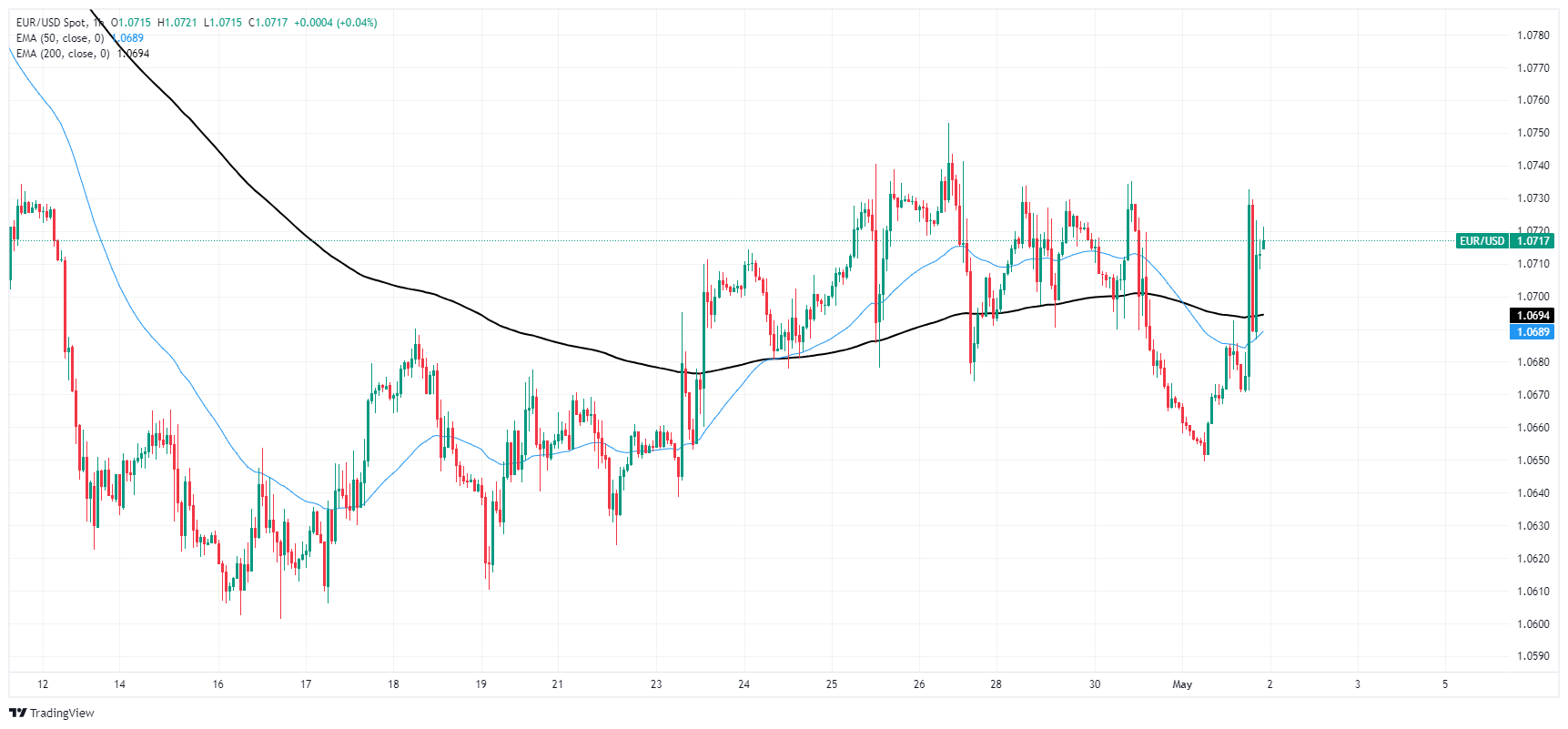
EUR/USD daily chart

-
01.05.2024 18:09EUR/USD jitters on reaction to Fed rate hold, FOMC press conference still on the cards
- EUR/USD bumped higher after Fed acknowledged easing inflation pressures.
- Rate markets still see November as a likely first rate cut.
- US NFP Friday to provide key labor figures.
EUR/USD bumped slightly higher after the Federal Reserve (Fed) released its latest rate outlook, with the US central bank citing an improvement in inflationary conditions, though targets remain unhit and progress has slowed. The US Dollar (USD) eased broadly and risk appetite is taking a cautious step forward.
Read more: Fed keeps interest rate unchanged at 5.25%-5.5% as forecast
Markets will be awaiting key statements from the Federal Open Market Committee's (FOMC) press conference due to begin at 18:30 GMT, presided over by Fed Chair Jerome Powell.
EUR/USD technical outlook
EUR/USD found some early bidding post-Fed monetary policy report, ticking closer to 1.0700 as the pair springboards off intraday technical support from the 200-period Exponential Moving Average (EMA) near 1.0675 on five-minute charts.
A near-term technical ceiling remains firmly baked in at the 200-hour EMA at 1.0695, and a heavy supply zone is priced in above 1.0730 after last week's peak near 1.0750.
EUR/USD five-minute chart

EUR/USD hourly chart
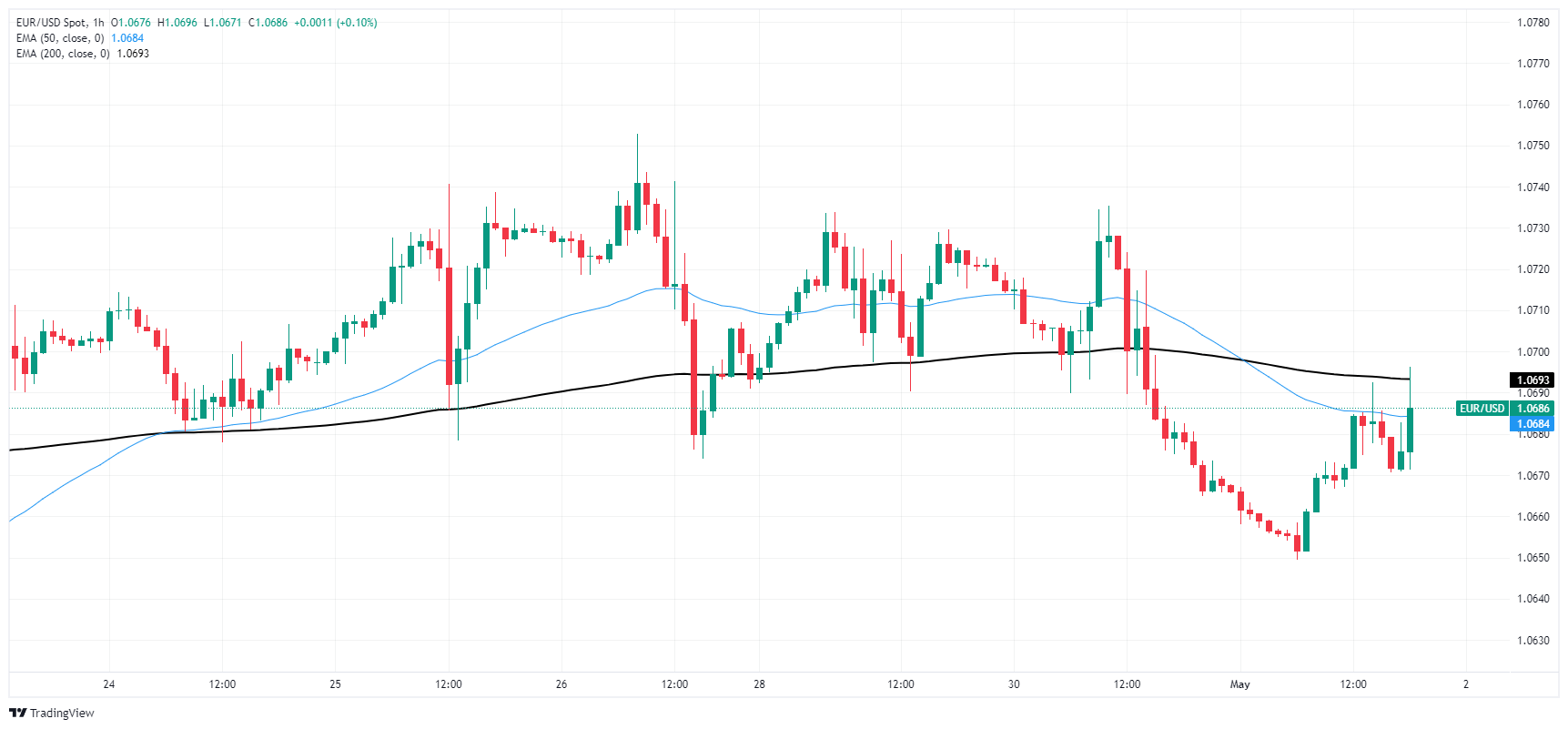
-
01.05.2024 14:42EUR/USD holds mildly up after US data, Fed looms
- Labor data from April from the US came in mixed and ISM PMIs disappointed.
- The FOMC is anticipated to deliver a hawkish hold, setting a vital economic direction for markets.
- In case the Fed shows itself hawkish, the markets could adjust its expectations further, fuelling additional gains to the USD.
The EUR/USD pair is trading mildly higher at 1.0682, with a daily variation of 0.12% on Wednesday’s session. The US reported soft ISM PMIs and Job Openings figures which seem to be weighing on the Greenback. However, the short-term direction of the pair will be dictated by the Federal Reserve (Fed) decision and messaging later in the session.
The latest data from the US Bureau of Labor Statistics revealed a decrease in Job Openings. In the last business day of March, openings dropped to 8.488M, down from March's revised figure of 8.813M and below the anticipated 8.680 M. Meanwhile, the US manufacturing sector experienced a decline in April, with the ISM Manufacturing PMI falling to 49.2 from 50.3 in March, missing the expected mark of 50.0, indicating a contraction in business activity.
On the positive side, private sector employment showed growth, according to data released by Automatic Data Processing. In April, the sector added 192K jobs, surpassing the forecast of 175K but still below March's revised increase of 208K jobs.
Regarding the Federal Reserve, it is anticipated to maintain a hawkish acknowledging persistent inflation and strong economic indicators. In addition, despite not updating its macroeconomic projections until June, the Fed is expected to point out recent deteriorations in the inflation outlook. Chair Powell's press conference will be crucial, with the potential to drop earlier guidance on easing, signaling a more cautious approach to monetary policy adjustments. Market expectations have shifted, significantly reducing the likelihood of rate cuts in the near future, and pushing the start of the easing cycle towards September of 2024.
EUR/USD technical analysis
On the daily chart, the Relative Strength Index (RSI) stands in negative territory with a recent reading of 44 indicating sustained bearish momentum. This coincides with the bearish atmosphere observed in the past sessions since early April, where all readings remained within the negative territory, none reaching passing above 50, signifying ongoing sellers' dominance in the market. That being said, the Moving Average Convergence Divergence (MACD) shows positive momentum, displaying green bars that currently remain flat which points out that there is some buying action.
However, the EUR/USD is trading below its 20, 100, and 200-day SMA. This implies sustained short-term, intermediate, and long-term selling pressure and as long as the buyers keep the pair below this level the outlook will be bearish.
EUR/USD daily chart
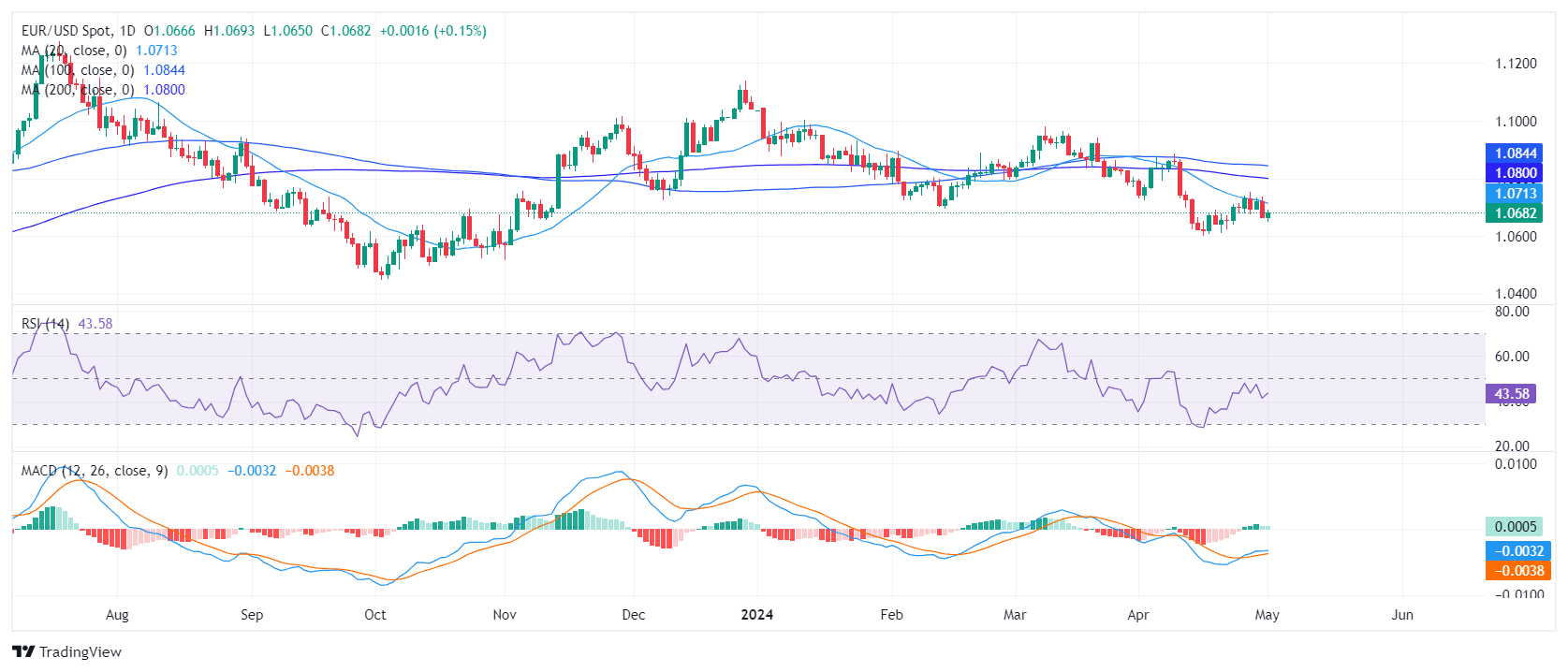
-
01.05.2024 11:01EUR/USD finds support near 1.0650, downside remains favored ahead of Fed policy
- EUR/USD finds a temporary support near 1.0650 though dismal market sentiment keeps the downside bias intact.
- Uncertainty ahead of the Fed’s policy has dampened the appeal of risk-sensitive assets.
- The ECB is widely anticipated to begin reducing interest rates from June.
The EUR/USD pair finds a provisional support near 1.0650 in Wednesday’s European session. The near-term outlook for the major currency pair remains bearish as investors are cautious ahead of the Federal Reserve’s (Fed) monetary policy announcement at 18:00 GMT.
Investors see the Fed keeping interest rates steady in the range of 5.25%-5.50% as inflationary pressures are significantly higher than the desired rate of 2%. Therefore, rate cuts at this stage could revamp price pressures again.
The Fed is expected to endorse a restrictive interest rate policy for longer due to a slew of hotter-than-expected inflation readings in the January-March period. The Q1 Employment Cost Index released on Tuesday was also stronger than consensus, deepened fears of inflation remaining persistent ahead. The index rose strongly by 1.2% in comparison with the estimates of 1.0% and the prior reading of 0.9%.
Meanwhile, the market sentiment is extremely cautious ahead of Fed’s policy meeting. S&P 500 futures have posted significant losses in the London session, exhibiting a sharp decline in the risk-appetite of the market participants. 10-year US Treasury yields rise to 4.69% on expectations of a hawkish guidance from the Fed. The US Dollar Index (DXY), which tracks the US Dollar’s value against six major currencies rose to 106.35.
On the Eurozone front, the long-term outlook of the Euro is vulnerable as investors see the European Central Bank (ECB) starting to reduce interest rates from the June meeting. On Tuesday, ECB policymaker Pablo Hernandez de Cos supported for ECB pivoting to interest rate cuts from June if inflation continues to decline gradually. ECB Cos advised that the central bank should not commit a specific rate path and should use a data-dependent approach.
-
01.05.2024 04:28EUR/USD drops to near 1.0650 ahead of Fed policy
- EUR/USD depreciates due to risk-off sentiment ahead of the Fed interest rate decision on Wednesday.
- The stronger Employment Cost Index bolstered the strength of the US Dollar.
- The Euro failed to appreciate the robust Eurozone data released on Tuesday.
EUR/USD continues its decline for the second consecutive day, hovering around 1.0650 during Asian trading hours on Wednesday. With European markets largely closed for Labour Day, investors are expecting the Federal Reserve's (Fed) latest policy decision.
The US Dollar Index (DXY), which gauges the performance of the US Dollar (USD) against six major currencies, continues its rally following higher than expected Employment Cost Index data released on Tuesday. Additionally, hawkish remarks from Fed officials, signaling no immediate need for rate cuts, undermined the EUR/USD pair.
In the first quarter, the US Employment Cost Index surged by 1.2%, representing the largest increase in a year and exceeding both expectations of 1.0% and the previous figure of 0.9%. This recent data underscores prevailing wage pressures, which have the potential to magnify the impact of persistent inflation within the US economy.
Traders are anticipated to closely monitor the release of the ADP Employment Change and ISM Manufacturing PMI from the United States (US) on Wednesday, preceding the Fed's Monetary Policy Statement. These releases are likely to offer additional insights into the current state of the US economy.
On the Eurozone front, the Euro failed to sustain its gains despite robust Eurozone data released on Tuesday. The Eurozone Gross Domestic Product (GDP) expanded by a higher than expected 0.3% in the first quarter.
Furthermore, the Harmonized Index of Consumer Prices (HICP) has shown steady growth year-over-year, meeting expectations, while core HICP, excluding food and energy prices, has softened but still exceeded estimates.
Investor confidence remains strong regarding the European Central Bank (ECB) potentially implementing interest rate cuts in June, as a majority of ECB policymakers have expressed support for such a move.
-
30.04.2024 23:12EUR/USD tumbles out of recent range, tests below 1.0770 as markets flee into safe havens
- Euro slips to near-term lows as risk-off markets bid Greenback.
- European markets will be largely dark on Wednesday.
- Midweek Fed rate call on the cards.
EUR/USD slid below the 1.0670 level on Tuesday after an unexpected uptick in US wages growth reignited fears of sticky inflation, chopping down rate cut expectations and sending investors into safe haven bids.
With European markets broadly shuttered on Wednesday for Labour Day, investors will be left to focus on the Federal Reserve’s (Fed) latest rate call. Markets are broadly expecting the Fed to hold rates steady for the time being, but market participants will be actively looking for firmer policy guidance from the US central bank as inflation fears and a steep downturn in US economic growth figures plague market sentiment.
US housing prices and wage costs for businesses both showed acceleration on Tuesday, while consumer and business sentiment surveys turn sharply lower at the same time. Investors are grappling with the prospect of a stagnant economy with too-high inflation that will hobble the Fed’s ability to cut rates at the higher pace that investors have been hoping for since the start of 2024.
According to the CME’s FedWatch Tool, rate markets now only see a single rate quarter-point rate cut from the Fed for the year, with a 54% chance of no rate cut in September and only a 57% chance of a 25-basis-point rate trim at the Fed’s November policy meeting.
EUR/USD technical outlook
EUR/USD’s decline on Tuesday firmly knocked the pair below the 200-hour Exponential Moving Average (EMA) at 1.0800 as the pair tests into fresh weekly lows and in striking distance of a supply zone near 1.0660.
The pair is approaching April’s low bids near the 1.0600 handle, and EUR/USD is down around 2% from the last swing high at 1.0885.
EUR/USD hourly chart
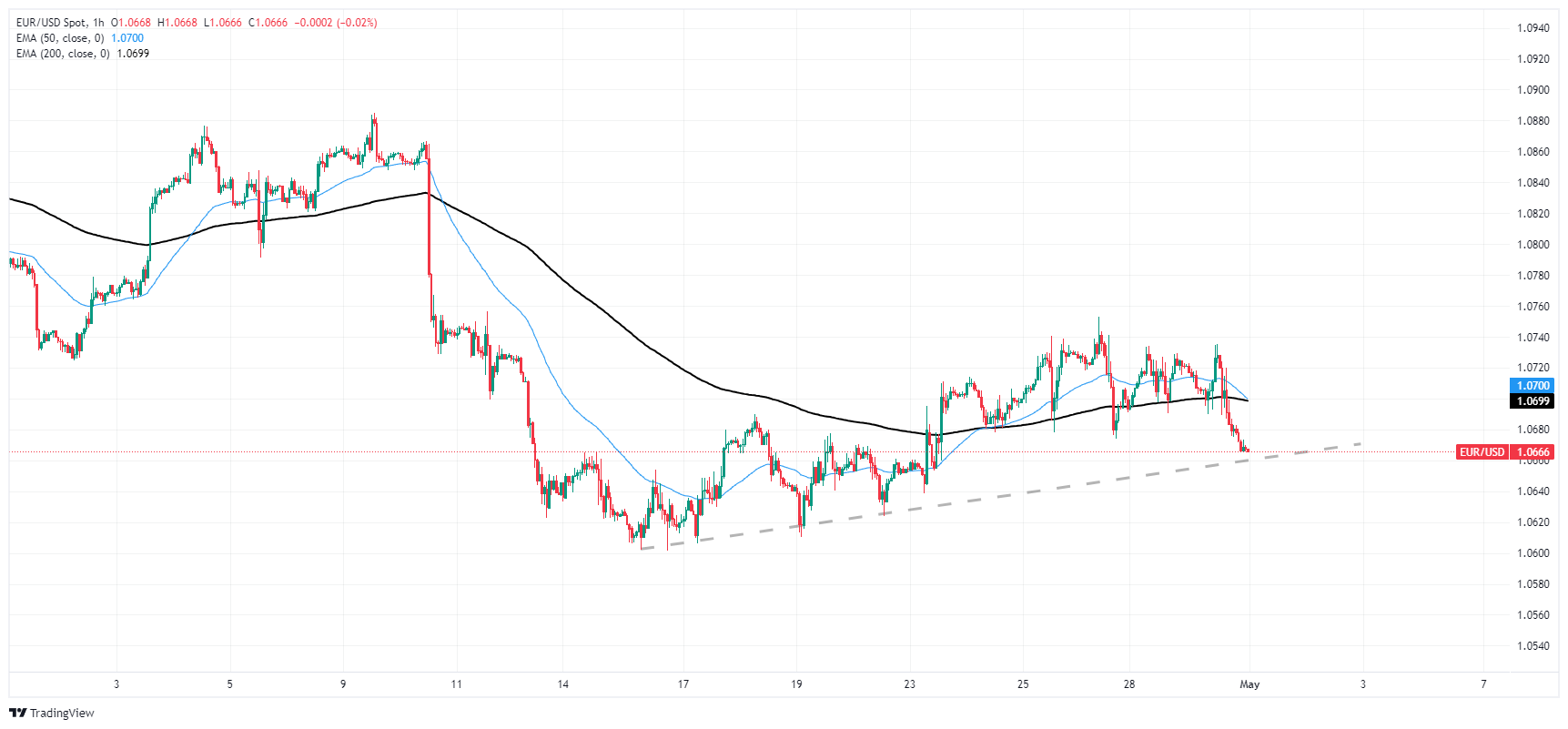
EUR/USD daily chart

-
30.04.2024 10:04EUR/USD capitalizes on sticky inflation, strong Q1 GDP report
- EUR/USD recovers sharply from below 1.0700 after upbeat Eurozone Q1 GDP, stubborn inflation data.
- Strong Eurozone data has raised concerns over ECB rate cuts from June.
- The US Dollar recovers amid caution ahead of the Fed’s policy decision.
EUR/USD bounces back strongly from below 1.0700 in Tuesday’s European session as the Eurozone preliminary inflation data for April and Gross Domestic Product (GDP) data for the first quarter have beat the consensus. Annually, the Harmonized Index of Consumer Prices (HICP) rose steadily and met estimates while core HCPI, that excludes food and energy prices, softened on a slower pace.
The Eurozone economy expanded at a stronger rate of 0.3% in the first quarter even though the European Central Bank (ECB) is maintaining its Main Refinancing Operations Rate at historic highs of 4.5%.
A sharp recovery in the Euro after the release of the key economic indicators suggests that investors’ confidence about the ECB pivoting to interest rate cuts from June would be significantly impacted. The speculation for the ECB reducing interest rates from June would be impacted in such a time when policymakers were divided over extending the rate-cut campaign to following meetings this year.
Daily digest market movers: EUR/USD rebounds after upbeat Eurozone data
- EUR/USD rebounds sharply from the crucial support of 1.0700 after the Eurostat reported that inflation remained hotter than expected in April and Q1 GDP outperformed estimates. Eurozone’s headline inflation rose in line with the consensus and the prior reading of 2.4%. The annual core inflation, which strips off volatile food and energy prices, grew at a higher pace of 2.7% from the estimates of 2.6% but decelerated from the prior reading of 2.9%.
- Monthly headline and core inflation rose by 0.6% and 0.7%, respectively. The Eurozone economy expanded at a strong rate of 0.3% in Q1, beating expectations of 0.1% and a stagnant performance in the last quarter of 2023. Annually, the Q1 GDP growth rate was double the expectations of 0.2%.
- Stronger-than-expected preliminary inflation for April, combined with robust Q1 GDP growth, is not expected to significantly impact expectations of rate cuts by the European Central Bank, which financial markets are expected to start in June.
- On the other side of the Atlantic, The US Dollar rebounds sharply as the market sentiment remains risk-off ahead of the Federal Reserve’s monetary policy decision, which will be announced on Wednesday. The US Dollar Index (DXY) recovers from 105.50 but remains inside two-week’s trading range of 105.40-106.50. The Fed is expected to keep interest rates unchanged in the range of 5.25%-5.50% for the sixth time in a row as price pressures in the United States remain stubbornly higher due to strong wage growth.
- The Fed will likely endorse keeping interest rates on hold at their current level for longer until it gets greater confidence that inflation will sustainably return to the desired rate of 2% target. Investors would look for whether the Fed will remain committed to its three rate-cut projections for this year provided in March’s dot plot.
- Apart from Wednesday’s Fed policy decision, investors will also focus on the US ADP Employment Change and the ISM Manufacturing Purchasing Managers Index (PMI) report for April.
Technical Analysis: EUR/USD finds strong buying interest near 1.0700
EUR/USD bounces back strongly from above the round-level support of 1.0700. The major currency pair attempts to break above the 20-day Exponential Moving Average (EMA), which trades around 1.0725.
The panoramic view of the EUR/USD pair indicates a sharp volatility contraction due to a Symmetrical Triangle formation on a daily timeframe. The upward-sloping border of the triangle pattern is plotted from October 3 low at 1.0448 and the downward-sloping border is placed from December 28 high around 1.1140.
The 14-period Relative Strength Index (RSI) shifts into the 40.00-60.00 range, suggesting indecisiveness among market participants.
Euro FAQs
The Euro is the currency for the 20 European Union countries that belong to the Eurozone. It is the second most heavily traded currency in the world behind the US Dollar. In 2022, it accounted for 31% of all foreign exchange transactions, with an average daily turnover of over $2.2 trillion a day. EUR/USD is the most heavily traded currency pair in the world, accounting for an estimated 30% off all transactions, followed by EUR/JPY (4%), EUR/GBP (3%) and EUR/AUD (2%).
The European Central Bank (ECB) in Frankfurt, Germany, is the reserve bank for the Eurozone. The ECB sets interest rates and manages monetary policy. The ECB’s primary mandate is to maintain price stability, which means either controlling inflation or stimulating growth. Its primary tool is the raising or lowering of interest rates. Relatively high interest rates – or the expectation of higher rates – will usually benefit the Euro and vice versa. The ECB Governing Council makes monetary policy decisions at meetings held eight times a year. Decisions are made by heads of the Eurozone national banks and six permanent members, including the President of the ECB, Christine Lagarde.
Eurozone inflation data, measured by the Harmonized Index of Consumer Prices (HICP), is an important econometric for the Euro. If inflation rises more than expected, especially if above the ECB’s 2% target, it obliges the ECB to raise interest rates to bring it back under control. Relatively high interest rates compared to its counterparts will usually benefit the Euro, as it makes the region more attractive as a place for global investors to park their money.
Data releases gauge the health of the economy and can impact on the Euro. Indicators such as GDP, Manufacturing and Services PMIs, employment, and consumer sentiment surveys can all influence the direction of the single currency. A strong economy is good for the Euro. Not only does it attract more foreign investment but it may encourage the ECB to put up interest rates, which will directly strengthen the Euro. Otherwise, if economic data is weak, the Euro is likely to fall. Economic data for the four largest economies in the euro area (Germany, France, Italy and Spain) are especially significant, as they account for 75% of the Eurozone’s economy.
Another significant data release for the Euro is the Trade Balance. This indicator measures the difference between what a country earns from its exports and what it spends on imports over a given period. If a country produces highly sought after exports then its currency will gain in value purely from the extra demand created from foreign buyers seeking to purchase these goods. Therefore, a positive net Trade Balance strengthens a currency and vice versa for a negative balance.
-
30.04.2024 04:31EUR/USD Price Analysis: Manages to hold above 200-hour SMA ahead of Eurozone CPI, FOMC
- EUR/USD comes under renewed selling pressure amid a modest pickup in USD demand.
- The technical setup warrants caution for bearish traders ahead of the key Eurozone CPI.
- The market focus will then shift to the FOMC policy decision, scheduled for Wednesday.
The EUR/USD pair meets with some supply during the Asian session on Tuesday and erodes a part of the previous day's gains amid the emergence of fresh US Dollar (USD) buying. Spot prices, however, remain in a familiar range held over the past week or so and currently trade around the 1.0700 round-figure mark.
Hawkish Federal Reserve (Fed) expectations help revive the US Dollar (USD) demand. This, along with bets that the European Central Bank (ECB) will cut interest rates in June, turn out to be key factors exerting some downward pressure on the EUR/USD pair. Traders, however, seem reluctant to place aggressive directional bets ahead of the Eurozone consumer inflation figures on Tuesday and the outcome of a two-day FOMC policy meeting on Wednesday.
From a technical perspective, any subsequent decline is more likely to find decent support near the 1.0690-1.0685 confluence, comprising the 200-hour Simple Moving Average (SMA) and over a one-week-old ascending trend line. A convincing break below might prompt some technical selling and drag the EUR/USD pair towards last week's swing low, around the 1.0625 region en route to the 1.0600 mark or the YTD trough touched earlier this month.
On the flip side, bulls need to wait for a sustained strength beyond the 1.0730-1.0740 supply zone before positioning for any further gains. The EUR/USD pair might then accelerate the positive move towards reclaiming the 1.0800 round figure before climbing to the 1.0835-1.0840 intermediate barrier and the monthly peak, around the 1.0885 region. This is followed by the 1.0900 mark, which if cleared will shift the near-term bias in favor of bullish traders.
EUR/USD 1-hour chart
-
29.04.2024 22:28EUR/USD finds support near 1.0720 after slow grind on Monday
- German CPI inflation continues to rise, but below forecasts.
- Fed rate call, pan-EU GDP and HICP inflation in the mid-week.
- NFP Friday a key US datapoint this week.
EUR/USD jostled on Monday, settling near 1.0720 after churning in a tight but lopsided range as markets settle in for the wait to Wednesday’s US Federal Reserve (Fed) outing. Investors broadly expect US rates to hold steady this week, but traders will be looking for an uptick in Fed guidance for when rate cuts could be coming. As of writing, the CME’s FedWatch Tool shows rate markets are pricing in 58% odds of a first rate cut in September.
German Consumer Price Index (CPI) inflation rose to 0.5% MoM in April, up from the previous month’s 0.4% but missing the forecast 0.6%. Germany’s YoY Harmonized Index of Consumer Prices (HICP) inflation ticked higher to 2.4%, compared to the forecast hold at 2.3%. Markets will be looking ahead to Tuesday’s HICP inflation for the pan-Euro area, which is expected to stand pat at 2.4% for the year ended April.
European Gross Domestic Product (GDP) figures are also due during Tuesday’s European market session, forecast to grind higher to a scant 0.1% in the first quarter compared to the previous quarter’s flat 0.0%.
The key headlines this week will be the Fed’s latest rate call on Wednesday, followed by Friday’s NFP labor data, which is expected to show a slight easing from the previous month’s 12-month peak of 303k. Friday’s US NFP is forecast to ease to 243k net additional job growth.
EUR/USD technical outlook
The EUR/USD churned just north of the 1.0700 handle on Monday as the pair continues to grind higher off of technical bounces from the 200-hour Exponential Moving Average (EMA) rising into the 1.0700 region. Chart paper north of 1.0750 is proving a difficult boundary to cross, and downside momentum, though sluggish, continues to keep the pair weighed down.
EUR/USD remains down 2.5% from the last major swing high into 1.0980, with a near-term price floor at 1.0600.
EUR/USD hourly chart

EUR/USD daily chart
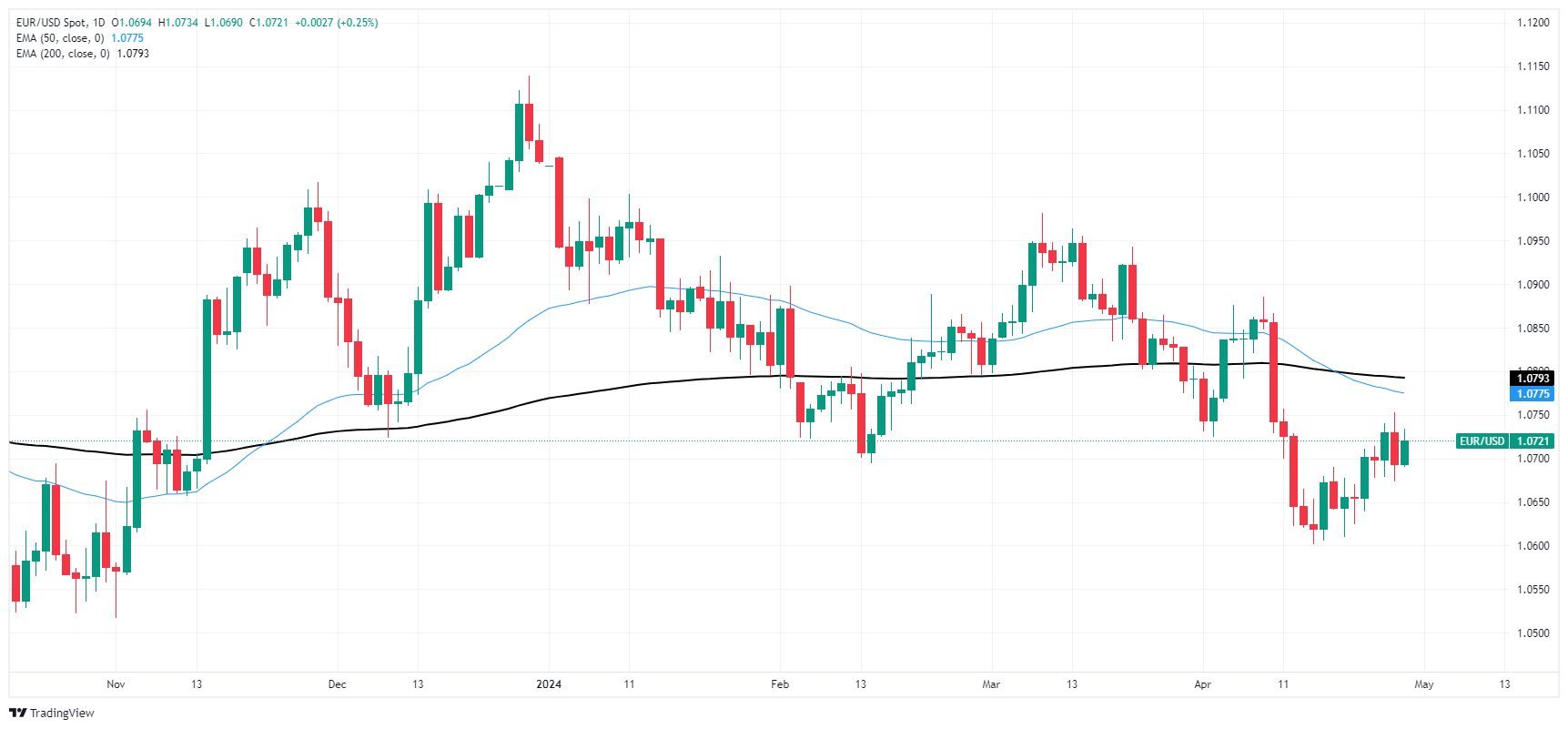
-
29.04.2024 10:10EUR/USD surrenders intraday gains ahead of US, Eurozone data-packed week
- EUR/USD struggles to hold gains above 1.0700 amid uncertainty ahead of key economic events.
- The ECB seems poised to start reducing key borrowing rates in June.
- Eurozone’s CPI, Q1 GDP and the Fed’s policy outlook will be in focus.
The EUR/USD pair struggles to sustain above the round-level resistance of 1.0700 in Monday’s European session. The major currency pair exhibits caution ahead of the release of key economic indicators in the Eurozone, such as preliminary Eurozone Q1 Gross Domestic Product (GDP) and the Consumer Price Index (CPI) data for April, which will be published on Tuesday.
Eurozone’s economic data will influence speculation about interest rate cuts by the European Central Bank (ECB). Currently, investors’ expectations that the ECB will start to cut its Main Refinancing Operations Rate from the June meeting strengthened as policymakers see them as reasonable.
Last week, Banque de France Governor and ECB Council member François Villeroy de Galhau said there is no need to wait much longer to start interest rate cuts if other things remain constant. Villeroy expects that energy prices are unlikely to rise further despite Middle East tensions and, hence, should not impact the ECB’s plans to pivot to interest rate cuts starting in June.
While a rate-cut move in the June meeting is widely expected, there is uncertainty over whether the ECB will extend the rate-tightening campaign. ECB policymakers share different opinions on that as Villeroy said last week: “June rate cuts should be followed by further cuts, at a pragmatic pace.” On the contrary, ECB policymaker and Bundesbank Chief Joachim Nagel said last week that a June interest rate cut may not necessarily be followed up by a series of rate cuts. Nagel remains worried about higher service inflation due to strong wage growth. He is not fully convinced that inflation will actually return to target in a timely and sustained manner.
In Monday’s session, investors will focus on the German preliminary inflation data for April, which will be published at 12:00 GMT. The annual Harmonized Index of Consumer Prices (HICP) is expected to have grown steadily by 2.3%.
Daily digest market movers: EUR/USD is off from daily high ahead of German data
- The EUR/USD retreats from the intraday high of 1.0734. The major currency pair fails to hold gains even though the market sentiment is favourable for risk-sensitive assets and the US Dollar edges down. Significant gains registered by S&P 500 futures indicate that the market sentiment is risk-on.
- The US Dollar remains on the backfoot due to uncertainty over the US economic outlook. The US Dollar Index (DXY), which tracks the Greenback’s value against six major currencies, fell to 105.60 as weak preliminary US economic indicators such as the S&P Global Purchasing Managers’ Index survey for April and Q1 GDP have raised concerns over the economy’s strength in coping with higher interest rates by the US Federal Reserve (Fed).
- The next move in the US Dollar will be guided by the Fed’s monetary policy decision, which will be announced on Wednesday. The US central bank is widely anticipated to keep interest rates steady in the range of 5.25%-5.50%. Therefore, investors will focus on the Fed’s guidance for interest rates. Considering the hot Q1 GDP Price Index and higher-than-expected US core Personal Consumption Expenditure Price Index (PCE) data for March, the Fed has no option but to deliver hawkish guidance on interest rates.
- Fed policymakers are expected to reiterate the need to maintain interest rates at their current levels until they get confidence that inflation will come down sustainably to the desired rate of 2% target. Investors will focus on whether the Fed remains committed to three rate-cut projections during 2024. Actually, the CME FedWatch tool shows that the US central bank will only make two rate cuts this year, and the September meeting is likely to be chosen as the earliest point.
Technical Analysis: EUR/USD aims for sustainability above 1.0700
The EUR/USD attempts to establish firm footing above the 1.0700 hurdle. The shared currency pair extends its recovery from 1.0600 to 1.0700, but the near-term outlook is still uncertain. The 20-day Exponential Moving Average (EMA) near 1.0720 remains a major barricade for the Euro bulls. The 200-day EMA near 1.0800 is declining, suggesting that the long-term appeal is bearish.
The 14-period Relative Strength Index (RSI) shifts into the 40.00-60.00 range, indicating a consolidation ahead.
The holistic view of the EUR/USD pair indicates a sharp volatility contraction due to a Symmetrical Triangle formation on a daily timeframe. The upward-sloping border of the triangle pattern is plotted from the October 3 low at 1.0448, and the downward-sloping border is placed from the December 28 high around 1.1140.
Euro FAQs
The Euro is the currency for the 20 European Union countries that belong to the Eurozone. It is the second most heavily traded currency in the world behind the US Dollar. In 2022, it accounted for 31% of all foreign exchange transactions, with an average daily turnover of over $2.2 trillion a day. EUR/USD is the most heavily traded currency pair in the world, accounting for an estimated 30% off all transactions, followed by EUR/JPY (4%), EUR/GBP (3%) and EUR/AUD (2%).
The European Central Bank (ECB) in Frankfurt, Germany, is the reserve bank for the Eurozone. The ECB sets interest rates and manages monetary policy. The ECB’s primary mandate is to maintain price stability, which means either controlling inflation or stimulating growth. Its primary tool is the raising or lowering of interest rates. Relatively high interest rates – or the expectation of higher rates – will usually benefit the Euro and vice versa. The ECB Governing Council makes monetary policy decisions at meetings held eight times a year. Decisions are made by heads of the Eurozone national banks and six permanent members, including the President of the ECB, Christine Lagarde.
Eurozone inflation data, measured by the Harmonized Index of Consumer Prices (HICP), is an important econometric for the Euro. If inflation rises more than expected, especially if above the ECB’s 2% target, it obliges the ECB to raise interest rates to bring it back under control. Relatively high interest rates compared to its counterparts will usually benefit the Euro, as it makes the region more attractive as a place for global investors to park their money.
Data releases gauge the health of the economy and can impact on the Euro. Indicators such as GDP, Manufacturing and Services PMIs, employment, and consumer sentiment surveys can all influence the direction of the single currency. A strong economy is good for the Euro. Not only does it attract more foreign investment but it may encourage the ECB to put up interest rates, which will directly strengthen the Euro. Otherwise, if economic data is weak, the Euro is likely to fall. Economic data for the four largest economies in the euro area (Germany, France, Italy and Spain) are especially significant, as they account for 75% of the Eurozone’s economy.
Another significant data release for the Euro is the Trade Balance. This indicator measures the difference between what a country earns from its exports and what it spends on imports over a given period. If a country produces highly sought after exports then its currency will gain in value purely from the extra demand created from foreign buyers seeking to purchase these goods. Therefore, a positive net Trade Balance strengthens a currency and vice versa for a negative balance.
-
29.04.2024 06:13EUR/USD Price Analysis: Keeps steady above 1.0700 amid shift to upward momentum
- EUR/USD holds its position above the psychological level of 1.0700 amid a momentum shift toward an upward trend.
- The immediate barrier appears around the major level of 1.0750, aligned with the upper boundary of the descending channel.
- A break below 1.0700 could lead the pair toward the support level of 1.0650 and April’s low of 1.0601.
EUR/USD recovers its recent losses registered in the previous session, trading around 1.0720 during the Asian session on Monday. From a technical perspective, analysis indicates a weakening bearish sentiment for the pair as it continues to advance within the descending channel, breaching the key psychological level of 1.0700.
Furthermore, the lagging indicator Moving Average Convergence Divergence (MACD) suggests a shift toward upward momentum for the EUR/USD pair. Although positioned below the centerline, it exhibits divergence above the signal line.
The EUR/USD pair faces an immediate barrier at the major level of 1.0750, corresponding with the upper boundary of the descending channel. A successful breakthrough above this level could provide upward momentum for the pair, targeting the area near the psychological milestone of 1.0800, followed by April’s high at 1.0885.
On the downside, key support for the EUR/USD pair is anticipated around the psychological threshold of 1.0700, coinciding with major support at 1.0695. A breach below this level could exert downward pressure on the pair, potentially driving it toward the vicinity of the major support level at 1.0650. Further support levels may emerge around April’s low at 1.0601, aligning with the lower boundary of the descending channel.
EUR/USD: Daily Chart
-
29.04.2024 00:50EUR/USD holds positive ground above 1.0700, eyes on German CPI data
- EUR/USD gains ground 1.0710 amid the softer USD on Monday.
- The US PCE inflation rose by 2.7% YoY in March, compared to 2.5% prior, which was hotter-than-expected.
- The ECB might cut interest rates before the Fed amid the cooler inflation in the Eurozone.
The EUR/USD pair trades on a stronger note around 1.0710 during the early Asian trading hours on Monday. The weaker US Dollar (USD) below the 106.00 mark provides some support to the major pair. The first reading of the German Consumer Price Index (CPI) for April is due on Monday. All eyes will be on the Federal Reserve monetary policy meeting on Wednesday, with no change in rate expected.
The recent US inflation data dialed back their expectation of when the Federal Reserve (Fed) will start cutting interest rates. According to the CME FedWatch tool, the chance of a rate cut by the July meeting falls from 50% last week to 25%, while traders have priced in nearly 60% odds that the Fed will cut the interest rate at its September meeting. This, in turn, might lift the Greenback and cap the upside of the EUR/USD pair in the near term.
The US Bureau of Economic Analysis revealed on Friday that the Personal Consumption Expenditures (PCE) Price Index rose by 2.7% YoY in March, compared to the previous reading of 2.5%, above the 2.6% estimated. The Core PCE figure, the Fed's preferred inflation measure, held steady at 2.8% YoY in March, firmer than the 2.6% expected. On a monthly basis, both headline PCE and the core PCE Price Index rose 0.3% in March.
Across the pond, the European Central Bank (ECB) emphasized cooler inflation in the Eurozone and signaled that the ECB might cut interest rates before the Fed. ECB President Christine Lagarde hinted that the central bank is still likely to begin lowering its deposit rate from a record-high 4% in June, but has been careful to leave open its options for the path beyond. -
26.04.2024 08:33EUR/USD continues slogging higher prior to March US core PCE
- EUR/USD steadily climbs back above 1.0700 again despite weakness following inflationary US GDP data.
- Further volatility is possible once the core Personal Expenditures Price Index for March is released on Friday.
- The report could further tone the outlook for US interest rates, impacting the value of USD.
EUR/USD trades in the 1.0740s on Friday, ahead of key data out of the US in the form of the March core Personal Consumption Expenditures Price Index (PCE), the US Federal Reserve’s (Fed) preferred gauge of inflation.
The pair lost ground on Thursday after the release of the Q1 US GDP report but has since recovered and resumed its short-term uptrend.
The core PCE data, which is released by the US Bureau of Economic Analysis (BEA) at 12:30 GMT, could alter market perceptions about the timing of Fed interest-rate cuts with implications for EUR/USD.
EUR/USD recovers from post-GDP data decline
EUR/USD has recovered back up to the 1.0730s after declining sharply to a low of 1.0678 on Thursday following the release of US first-quarter GDP data. Although annualized GDP growth missed consensus expectations and fell below the previous quarter’s growth rate, the Personal Consumption Expenditures Prices component, which measures the change in prices of goods, came in way higher compared with previous quarter and supported the US Dollar (USD).
The inflationary data meant that markets dialed back their expectation of when the Federal Reserve (Fed) will start cutting interest rates, with the chance of a rate cut by the July meeting falling from 50% on the previous day to 34% afterwards, according to analysts at Deutsche Bank.
The expectation of interest rates staying higher for longer temporarily strengthened the Greenback – but weighed on EUR/USD – because higher interest rates attract more foreign capital inflows.
EUR/USD at risk of more volatility
EUR/USD may now be vulnerable to more volatility when the monthly core PCE is released at 12:30 GMT. Although the market has already been alerted to a likely upside surprise by the data in the GDP report for the quarter, the core PCE for March out on Friday will provide more detail.
EUR/USD is likely to decline if core PCE shows a reading that is higher than the 2.6% expected by economists (0.3% MoM), particularly if it is above the 2.8% reading from the previous month. A higher-than-forecast reading would indicate persistent price pressures and encourage the Fed to maintain interest rates at their current level for longer.
A lower-than-forecast reading would bring forward the time the Fed is expected to make its first interest-rate cut, weakening USD and lifting the EUR/USD exchange rate.
The CME FedWatch Tool, a market-based gauge of when the Fed is likely to alter interest rates, places the first rate cut as happening in September, with a 59% probability.
Beyond the US PCE data, the calendar shows little in the way of hard data that is likely to impact the Euro (EUR) side of the pair, although commentary from European Central Bank (ECB) officials could still cause some turbulence.
Technical Analysis: EUR/USD continues slowly correcting higher
EUR/USD continues correcting higher despite experiencing a pullback down below the 1.0700 level after the release of US GDP data on Thursday.
It has broken out of the rectangular range it was trading in on the 4-hour chart after piercing above the rectangle’s ceiling at 1.0700.
The Bear Flag price pattern which was unfolding between April 16-22 looks deformed by the persistent price action above 1.0700 and is less credible.
EUR/USD 4-hour Chart
The establishment of a rising sequence of peaks and troughs on the 4-hour chart strengthens the argument that the short-term trend has turned bullish and therefore suggestive of more gains.
If it continues marching higher, resistance from a previous lower high on April 11 gives an initial target at 1.0757. Then the 50-day and 200-day Simple Moving Averages (SMA) on the daily chart (not shown) are likely to resist at 1.0807.
On the other hand, a break below the 1.0601 April 16 low would revive the Bear Flag hypothesis.
According to technical lore, the expected move down from a Bear Flag equals the length of the preceding “pole” or a Fibonacci ratio of the pole.
The Fibonacci 0.618 ratio of the pole extrapolated lower gives a conservative target at 1.0503. The next concrete target is at 1.0448 – the October 2023 low. A fall of equal length to the pole would take EUR/USD to 1.0403.
Economic Indicator
Core Personal Consumption Expenditures - Price Index (YoY)
The Core Personal Consumption Expenditures (PCE), released by the US Bureau of Economic Analysis on a monthly basis, measures the changes in the prices of goods and services purchased by consumers in the United States (US). The PCE Price Index is also the Federal Reserve’s (Fed) preferred gauge of inflation. The YoY reading compares the prices of goods in the reference month to the same month a year earlier. The core reading excludes the so-called more volatile food and energy components to give a more accurate measurement of price pressures." Generally, a high reading is bullish for the US Dollar (USD), while a low reading is bearish.
Read more.Next release: Fri Apr 26, 2024 12:30
Frequency: Monthly
Consensus: 2.6%
Previous: 2.8%
Source: US Bureau of Economic Analysis
After publishing the GDP report, the US Bureau of Economic Analysis releases the Personal Consumption Expenditures (PCE) Price Index data alongside the monthly changes in Personal Spending and Personal Income. FOMC policymakers use the annual Core PCE Price Index, which excludes volatile food and energy prices, as their primary gauge of inflation. A stronger-than-expected reading could help the USD outperform its rivals as it would hint at a possible hawkish shift in the Fed’s forward guidance and vice versa.
-
26.04.2024 05:16EUR/USD trades with negative bias, holds above 1.0700 as traders await US PCE Price Index
- EUR/USD meets with some supply amid the emergence of some USD buying on Friday.
- Bets that the Fed will keep rates higher for longer amid sticky inflation underpin the USD.
- Traders, however, seem reluctant and look to the US PCE Price Index for a fresh impetus.
The EUR/USD pair edges lower during the Asian session on Friday and moves away from a two-week high, around the 1.0740 area touched the previous day. Spot prices currently trade around the 1.0725-1.0720 region and remain at the mercy of the US Dollar (USD) price dynamics ahead of the crucial US data.
The US Personal Consumption Expenditures (PCE) Price Index data is due for release later during the North American session and will be looked upon for cues about the Federal Reserve's (Fed) rate cut path. This, in turn, will play a key role in influencing the near-term USD price dynamics. In the meantime, growing acceptance that the US central bank will keep interest rates higher for longer lends some support to the Greenback and exerts some downward pressure on the EUR/USD pair.
Investors have pushed back their expectations about the timing of the first rate cut by the Fed to September. The bets were reaffirmed by data released on Thursday, which showed that the underlying inflation rose more than expected in the first quarter. This helps offset a deceleration in the economic growth to a 1.6% annualized rate during the January-March quarter – marking the weakest reading since mid-2022 – and keeps the US Treasury bond yields elevated, underpinning the USD.
Apart from this, bets that the European Central Bank (ECB) will start cutting interest rates in June, amid a faster-than-anticipated fall in the Eurozone inflation, suggests that the path of least resistance for the EUR/USD pair is to the downside. That said, it will still be prudent to wait for strong follow-through selling before confirming that the recent recovery from the 1.0600 mark, or the YTD low has run its course traders await the key US inflation data.
© 2000-2024. All rights reserved.
This site is managed by Teletrade D.J. LLC 2351 LLC 2022 (Euro House, Richmond Hill Road, Kingstown, VC0100, St. Vincent and the Grenadines).
The information on this website is for informational purposes only and does not constitute any investment advice.
The company does not serve or provide services to customers who are residents of the US, Canada, Iran, The Democratic People's Republic of Korea, Yemen and FATF blacklisted countries.
Making transactions on financial markets with marginal financial instruments opens up wide possibilities and allows investors who are willing to take risks to earn high profits, carrying a potentially high risk of losses at the same time. Therefore you should responsibly approach the issue of choosing the appropriate investment strategy, taking the available resources into account, before starting trading.
Use of the information: full or partial use of materials from this website must always be referenced to TeleTrade as the source of information. Use of the materials on the Internet must be accompanied by a hyperlink to teletrade.org. Automatic import of materials and information from this website is prohibited.
Please contact our PR department if you have any questions or need assistance at pr@teletrade.global.

